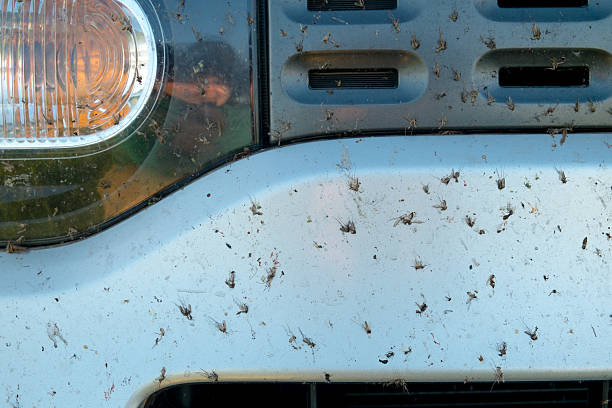Gnats in cars are very irritating. We all know the feeling. You’re driving along, minding your own business, when suddenly you feel something crawling on your arm. You swat at it, but it’s too late. These pesky little creatures are more than just a nuisance. They can actually be dangerous to your health. That’s why it’s important to know how to get rid of them.
In this blog, we’ll share some tips and tricks for getting rid of gnats in car. We’ll also provide some insights into why they’re attracted to cars in the first place. So whether you’re dealing with a few gnats or an infestation, we’ve got you covered.

Contents
Why do Gnats Like Cars – Attraction to Smells
Gnats in cars are small, often invisible to the naked eye, insects that are closely related to flies. While not all species of gnat bites, those that do can be a real nuisance, particularly if they swarm around your car. So why do gnats like cars? Gnats in Car usually attracted by different smells.
What Smell Drives Gnats Away – Lemon or Vanilla Spray
How Can You Get Rid of Gnats in Your Car – 3 Ways
If you have a gnats in car, there are a few things you can do to get rid of them.
- Firstly, make sure that you don’t have any food or crumbs lying around in your car. Even a small amount of food can attract gnats.
- Secondly, try to keep your windows closed as much as possible to prevent them from getting inside.
- Finally, you can use a bug spray or a Gnat Stick® to kill the gnats in car.
What Attracts Gnats to Cars?
Gnats in Cars are attracted to carbon dioxide, which is why they often fly around people’s heads. They are also attracted to heat, light and movement. All of these things can be found in abundance around a car.
The gnats are most likely to be found near the exhaust pipe, where the carbon dioxide is concentrated, or near the headlights, where it is warm and there is light. Gnats in Car are very irritated.
Common Gnats in Cars & Car Gnats Control
To an insect, your car is essentially no different from your home. It’s a warmer space with places to hide that provides protection from predators and possible access to food. As a result, almost any pest can find its way into a car. Some of the most frequent invading insects include:
- Ants – An ant infestation in a car is usually caused by a food source such as leftover food or a spill. Ants can smell food from several meters away and enter the car through a small crack to reach it. If your car is regularly parked near the ant colony, ants will be able to remember it, and it can provide an ongoing food source if not properly handled. You can also get rid of ants in a car naturally.
- Roaches – You will most often find cockroaches in a car when they have a source of food, such as leftover crumbs, and water. They can crawl in through tiny cracks or be carried in on clothing or belongings. Roaches are known to carry bacteria and cause diseases like salmonella. They can survive off very little food, so a cockroach infestation in a car can grow quickly, even if you clean.

- Spiders – Most spiders are harmless to people, and can be killed or captured and removed if you find one in your car. If you are frequently noticing spiders in your car, this can indicate a presence of other bugs that are serving as their food source, or a more significant problem with local pests in general.
- Bed Bugs – Despite their name, bed bugs can be found in locations without beds, including your car. Bed bugs feed off of your blood and are one of the few pests that can be sustained in even the cleanest cars. They prefer feeding at night but have no problems feeding in the day, and they often hide so well that those with bed bugs in their cars rarely know they’re there.
- Carpet Beetles – Carpet beetles are a unique invading bug. The larvae for these beetles eat natural fibers, such as wool and leather found in cars. Larvae can eat holes in seats and flooring, and can also irritate the skin. Adult carpet beetles feed on pollen instead of fibers, but their presence in your car could mean eggs or larvae are nearby.
Once inside, each pest’s behavior depends on the insect. They all require a continuous source of food, and will often leave a car if food is no longer available. Most regularly used cars, however, can provide the sustenance that pests need, making it possible for the infestation to last. Because pests are also survivors, abandoning your car is not only impractical for your life – it may not even be enough.
How to Get Rid of Roaches, Spiders, Ants, and Bed Bugs in a Car – 6 Steps
Bugs typically find their way into your car by climbing in through a crack or open window or by clinging to the rider’s clothing or belongings. Bugs will often come in to escape the elements, but an infestation can happen at any time of the year if your car has food and a way to get inside.
Taking these preventative steps can make your car less appealing to bugs and reduce the risk of an infestation:
- Keep Windows Closed – When the car is parked, keep windows rolled up. Even a small gap can be enough space for most bugs to enter through.
- Remove Food and Drink Containers – After eating in your car, the smell and residue on the containers that held your food can attract pests.
- Clean Up Spills – As soon as possible, clean up any food or drink spills. Use a gentle cleaning solution and cloth on plastic surfaces, and carpet shampoo for floors and cloth seats to remove any residue.
- Vacuum Regularly – Vacuuming removes stray crumbs that could be a food source for pests. It can also catch pests like ants and bed bugs to keep the population under control.
- Check For Hitchhiking Pests – Before loading your car, check all boxes, bags, and luggage for any pests that may be riding along.
- Get a Car Wash – A regular car wash can remove any pests living outside, like spiders before they can make their way into the interior. Many of these steps can be enough to remove insects that have invaded your vehicle. Cleaning spills and crumbs eliminate the bugs’ food source, forcing them to go elsewhere. Vacuuming can physically remove bugs and their eggs, though some pests – like bed bugs – are very likely to need additional support
How can you Prevent Gnats from Getting in Your Car?
There are several ways to prevent gnats from getting in your car.
- One way is to keep your car clean. Gnats are attracted to dirt and debris, so by keeping your car clean, you can make it less attractive to them.
- Another way is to keep food and garbage out of your car. If you have food or garbage in your car, gnats will be attracted to it and may enter your car in search of a meal.
- Finally, you can seal any cracks or openings in your car that may provide an entry point for gnats. By sealing these openings, you can make it more difficult for gnats to enter your car and reduce the chances of them becoming a nuisance.
What do Gnats do When they’re in your Car?
Gnats are small, fly-like insects that are attracted to the carbon dioxide that we exhale. When they sense the presence of people or animals, they will often congregate in large numbers in an attempt to get close to the source of the CO2.
Gnats in cars can lead them into your car, where they will often fly around aimlessly or land on surfaces inside the vehicle. While they are not harmful to humans, their presence can be annoying, and they can also stain surfaces with their feces. If you have a gnat problem in your car, there are a few things you can do to get rid of them.
FAQ (Frequently Asked Questions)
Are Gnats Harmful to Your Car?
Gnats are small, flying insects that are often attracted to car exhaust fumes. While they are not harmful to your car, they can be a nuisance. If you find yourself with a gnat problem, there are a few things you can do to get rid of them.
Why Do Gnats Fly Around My Car?
How Do I Get Rid of Little Flying Bugs in My Car?
Will Gnats Eventually Go Away?
How Do I Know if I Have Gnats in My Car?
If you have noticed small fruit flies or gnats in your car, there are a few things you can do to get rid of them. First, try to identify where they are coming from. Check for decaying food, spilled drinks, or any other organic matter that may be attracting them. If you can’t find the source, try placing a bowl of vinegar or soap water in your car overnight to see if it attracts any gnats. If it does, dispose of the water and bowl in the morning and clean the area where you found them. You can also try placing some citrus peels in your car to repel them.
What Can I Do to Prevent Gnats in My Car?
To prevent gnats in your car, take the following precautions:
- Keep food and garbage securely covered.
- Don’t leave spills or crumbs behind.
- Clean up pet food and water dishes regularly.
- Try using a Dashboard Gel to attract and trap gnats.

